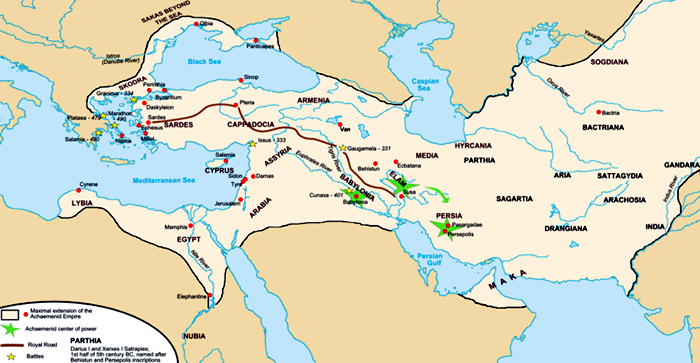 Persian Empire
Persian Empire

(Text by Duane R. Hurst © 2013)
Click on a link to view its information and pictures.
|
PERSIAN LINKS: Significant Event: Battle of Issus Behistun Inscription of King Darius Main Cities: Persepolis; Susa Time: 539-330 BC Language: Aramaic; Egyptian; Old Persian; Sumerian Personage: Cyrus; Darius; Xerxes I Religion: Persian Gods Related Country: Iraq; Iran |
|
|
Brief History: I have included only a few items concerning the history of this empire. A good source for more details can be found on Wikipedia or in history books. EARLY YEARS: Prior to the rise of Persia, Susa was a city associated with Sumeria and the capital of Elam. In 646 BC, King Ashurbanipal of the Assyrian Empire conquered Elam and sacked Susa. Deioces later united Median tribes, ousted the Assyrians and founded the Median Empire. His grandson, Nebopolassar, expanded the Chaldean Empire (aka Neo-Babylonia) and destroyed Nineveh in 612 BC. EARLY EMPIRE: Cyrus the Great unified the Persians and Medes into the Persian Empire. He conquered the Median Empire, Lydia and Neo-Babylonia. He failed to invade Egypt due to his death in battle with the Massagetae people along the Syr Darya River on 4 December 530 BC. The son of Cyrus, Cambyses II, defeated the Egyptian army at Pelusium in 525 BC and conquered Egypt. Cambyses was unable to attack Carthage because Phoenicians refused to fight their kinsmen. Tradition held that Cambyses lost a 50,000-man army in a sand storm while attempting to seize the Siwa Oasis. Darius I succeeded to the throne and consolidated power over Egypt. He also conquered Ariana (modern Afghanistan), Bactria and the Indus region. After a siege of 1-1/2 years, Darius reentered a rebellious Babylon with the help of Zopyrus and later invaded Scythia. His army also conquered Thrace, setting the stage for action against the Greek city-states. WAR WITH GREEKS: From 499 to 493 BC, Ionian Greek Cities revolted against Persia and received military support from Athens and Eretria in 498 BC. King Darius I suppressed the rebellious Ionian cities on the west coast of Anatolia, and sent an invasion force against the Greek mainland. In 492 BC, Mardonius (son-in-law to Darius) reconquered Thrace and made Macedon a client state. A storm near Mount Athos destroyed many of the Persian ships, which halted the campaign. Darius sent warning to the Greek city-states in 491 BC, but Athens and Sparta executed the ambassadors. A large naval force under admiral Datis and troops under Artaphemes succeeded in enslaving people from many Greek islands and razed Eretria. Although they landed in the bay of Marathon, Athenian and troops from Plataea soundly routed the Persians at the Battle of Marathon in August/September 490 BC. In 480 BC, Persian king Xerxes I personally led a large army and naval force against Greece. They crossed the Hellespont unopposed, reportedly via pontoon bridges. Greeks originally planned to stop the Persians at the Vale of Tempe, but reconsidered that Thermopylae was better suited. The main Spartan army delayed due to a religious ceremony, but King Leonidas I led his personal guard of 300 men, who all died fighting Xerxes' personal elite force (The Immortals) in the Battle of Thermopylae. Simultaneously, Greek naval forces defeated Persian ships in the Battle of Artemisium. These actions allowed Greek city-states to prepare a defense. Athenians abandoned their city for safety on Salamis Island. During the Battle of Salamis in 480 BC, the Persian admiral (Ariabignes) died and a combined Greek naval fleet defeated the forces of King Xerxes. Although the king departed for home, he left a powerful army behind, under the command of general Mardonius. In August 479 BC, a combined Greek force under Spartan command defeated and killed Mardonius in the Battle of Plataea. On the same day a Greek fleet under Spartan king Leotychides routed a Persian army of 60,000 men at Mount Mycale and destroyed their ships. CYRUS THE YOUNGER: In 401 BC 12,900 Greek mercenaries fought with Cyrus the Younger against his brother, Artaxerxes, at the Battle of Cunaxa. Cyrus died and his Persian forces scattered. Only the Greek force remained viable, however, the Spartan general (Clearchus) and his senior officers foolishly accepted a dinner invitation from Artaxerxes. All were executed, while the Greek force made its way north to the Black Sea after selecting new leaders. Xenophon, one of the new commanders, related their adventure in his story "Anabasis". |
|
|
© Page Publisher: Duane R. Hurst
|


